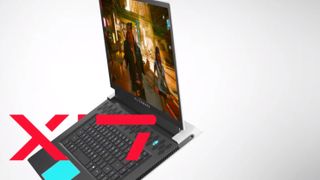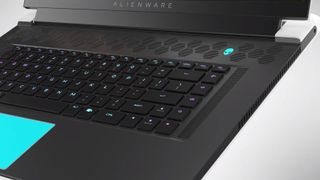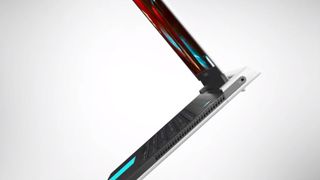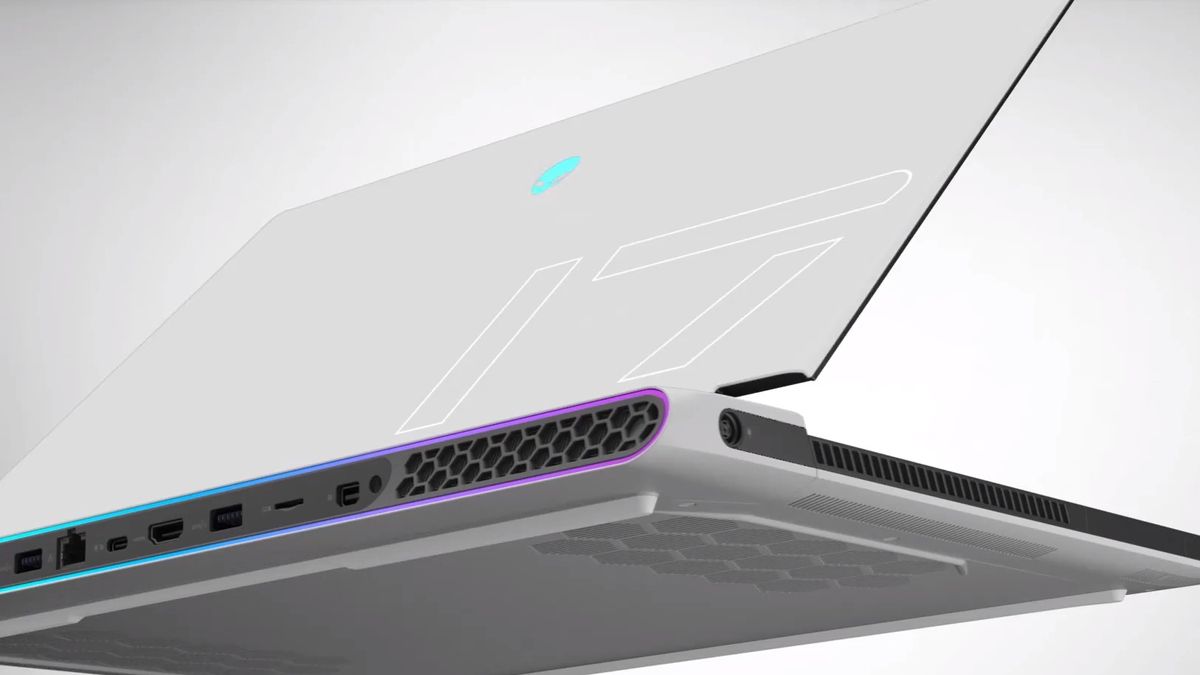12DOVE Verdict
A powerhouse redesign for the flagship Alienware line, the x17 R1 offers fantastic performance but with an eye-watering price tag.
Pros
- +
Gaming performance is top-notch
- +
Great keyboard and trackpad
- +
Beautiful display
- +
Wide range of physical ports
Cons
- -
Runs hot
- -
Undeniably expensive
- -
Fan whine can be annoying
Why you can trust 12DOVE
Nobody can claim right now that Dell has been sleeping on the job. The previous iteration of Alienware’s flagship 17.3-inch gaming laptop has barely been out for a year, and Dell is already pushing ahead with a shiny new version, naturally packing the latest in hard-to-find GPUs.
Yes, the new Alienware x17 R1 is a full-blooded RTX 3080 laptop under its sleek chassis, backed up by a powerful octa-core Intel processor and all the other internal hardware one of the best gaming laptops and one of the best Alienware gaming laptops needs. All of this is wrapped up inside a carefully redesigned exterior, promising to blow its predecessor out of the water. Of course, that performance comes at a price; our review model breaks through the $3,000 / £3,000 barrier and overall options start their prices at around $2,200 / £2,100.
Design
While it’s not a wild reimagining of the iconic Alienware laptop design, the x17 R1 does have one unique hook that grabs the eye as soon as you boot it up. The trackpad - a dull black rectangle on previous models - is now a vibrant RGB quadrilateral! Shockingly, this doesn’t improve your gaming performance, but it sure does look good.
Elsewhere, the RGB lighting seen in older iterations is still kicking. In addition to per-key RGB across the keyboard, the Alienware logo glows gently and a large ring of lighting surrounds the ports on the rear of the chassis. The exterior finish is a clean, familiar white (sorry, ‘Lunar Light’) while opening the lid reveals a black interior, all the better to showcase all that RGB - and to focus your eyes on the on-screen action.
The hexagonal venting above the keyboard also makes a return from previous versions, but hidden beneath it is a new proprietary cooling system. Dell reckons this is a pretty big deal; four internal fans and a specially-designed thermal interface material means that the x17 R1 should run cooler than its ancestors - although the bar is admittedly low there.

Features
Processor: Intel Core i7-11800H
Graphics: Nvidia GeForce RTX 3080
Memory: 16GB DDR4 RAM @ 3,200MHz
Display: 17.3-inch, 120Hz, 4ms
Resolution: 3840 x 2160
Storage: 512GB M.2 PCIe NVMe SSD
Ports: 1x HDMI, 2x USB 3.2 Gen1 Type-A, 1x USB 3.2 Gen2 Type-C, 1x Thunderbolt 4 USB Type-C, Micro SD, Mini DisplayPort 1x RJ45 Ethernet, 1x 3.5mm global headset jack
Connectivity: Killer WiFi 6 and Bluetooth 5.2
OS: Windows 11 Home 64-bit
Weight: 3.02kg
While it can be purchased with a conventional 1080p display, our review model of the x17 R1 has a 4K panel with a 120Hz refresh rate and 4ms latency. And what a gorgeous screen it is; colours are incredibly bright and vibrant, and gaming landscapes look absolutely stunning with the power of one of the best graphics cards, the RTX 3080, behind them.
In addition to the impressive display, Dell gives customers some different options for the keyboard too. Our unit has a traditional laptop membrane keyboard, which feels pretty good for both typing and gaming, but for an extra hundred or so dollars or pounds, you can spring for a mechanical version using Cherry MX ultra-low-profile switches for a superior gaming experience - something that evokes the feel of one of the best gaming keyboards.
Joining the GeForce RTX 3080 graphics card is an Intel Core i7-11800H CPU, 16GB of high-speed RAM, and a 512GB SSD. The latter two of these are upgradable to 64GB and 2TB respectively, although that naturally leads to a further price hike.
The new cooling system means that some of the ports have been repositioned to the rear of the laptop, leaving just the charging port and headphone jack on the left and right sides respectively. At the back, we’ve got a healthy selection: Two each of USB Type-A and Type-C (one of which is Thunderbolt 4 enabled), HDMI 2.1, microSD, Ethernet, and mini DisplayPort.
Beyond that, there’s not much else to highlight; the x17 R1 is already a powerhouse, and it doesn’t need many bells and whistles to show off. Killer Wi-Fi 6, an IR webcam with Windows Hello support, and a TPM 2.0 chip for Windows 11 support all serve to round off the package.

Performance
We put the Alienware x17 R1 to the test on some well-known benchmarking exercises, and here's how it matched up:
Firestrike: 18,061
TimeSpy: 8,040
Cinebench CPU: Multi (Index): 1,686
CrystalDiskMark: 2348MB/s read; 1427MB/s write
Tom Clancy's The Division 2: Ultra at 4K: 59 fps; Ultra at 1080p: 112 fps; High at 4K: 70 fps; High at 1080p: 128 fps
Metro Exodus: Ultra (RTX) at 4K: 28 fps; Ultra (RTX) at 1080p: 59 fps: High at 4K: 58 fps; High at 1080p: 106 fps
Shadow of the Tomb Raider: Highest at 4K: 58 fps; Highest at 1080p: 99 fps: High at 4K: 64 fps; High at 1080p: 119 fps
Total War: Three Kingdoms: Ultra at 4K: 32 fps; Ultra at 1080p: 92 fps; High at 4K: 45 fps; High at 1080p: 118 fps
It should come as no surprise to anybody that the Alienware x17 R1 is among the best of the best when it comes to gaming laptop performance - pushing the likes of the best gaming PCs even, and echoing the level of performance that you'd get from Alienware gaming PCs, too. Although the Shadow of the Tomb Raider test gave us some unexpectedly low results during 1080p testing, we found that the x17 R1 never dipped below 60fps at 1080p and 1440p resolutions in any of the games we tested.
At 4K, we get a slightly different story, but nothing that really surprised us. This compact RTX 3080 can’t quite keep up with its chunky desktop siblings, but it still offers incredible performance for a laptop GPU. Everything we tested was playable above 30fps at 4K, with esports titles like Overwatch running comfortably above 60fps. Engaging RTX settings in compatible games did result in a performance tradeoff, but not as bad as we saw in previous-gen GPUs.
The processor seems to be holding the x17 R1 back somewhat in certain games; for example, strategy title Total War: Three Kingdoms is CPU-bound, and didn’t perform quite as well in benchmarking as the other games we tested. To verify this, we monitored processor temperatures and also tested Total War: Warhammer II, which saw similar results and a toasty CPU.
So, how does that flashy quad-fan cooling system hold up? Well, this laptop certainly does get warm while running games, and in ‘performance mode’ the fans are extremely noisy (though not noticeable if you’re wearing a top PC headset for gaming). We’re not convinced that the new cooling setup is really that much better than older models, but intensively stress testing the CPU and GPU didn’t see us hit dangerously high temperatures so it does at least work pretty well.
A bigger issue for us was the fan noise while idling or running non-intensive programs. Even just sitting on the desktop with the system powered on produces quite a high-pitched whine that will likely prove irritating for some users. Whether this is a result of the quad-fan configuration is unclear, but it wasn’t as pronounced in older Alienware laptops.

Should you buy the Alienware x17 R1?
Despite its noisy fans, the Alienware x17 R1 is a beast of a gaming laptop that will serve as an ideal desktop replacement for any serious gamer. Not only does the subtly altered chassis look fantastic, but the gaming performance is top-notch, suitable for the most demanding games in glorious, vivid 4K.
Our biggest qualm about the x17 R1 is likely to be shared by many potential buyers: the blistering £3K+ price tag. It does come with a year’s premium tech support from Dell but the fact is that this is a seriously expensive laptop. The likes of an RTX 3060 laptop or an RTX 3070 laptop are going to be easier on the wallet, but if you’ve got the cash and want the best, though, the x17 R1 blows its predecessors out of the water.
We're also rounding up all the best Razer gaming laptops on the market right now if you're looking for more slimline designs.
If so, we'd also recommend checking out the best gaming desks and the best gaming chairs for a full setup.
Christian is a writer for Maximum PC, but also writes in a freelance capacity for a number of other sites including GamesRadar, PC Gamer, and TechRadar. He knows the PC gaming space inside out, particularly when it comes to hardware including PC builds, keyboards, and other peripherals.

Ahead of GTA 6, Take-Two CEO says he’s “not worried about AI creating hits” because it’s built on recycled data: “Big hits […] need to be created out of thin air”

Getting Over It creator Bennett Foddy threatens the world once again: If you want Baby Steps to be a brutal rage game, "you can inflict that on yourself"

A Simpsons Hit and Run Remake will probably never happen – and I don't want it to












